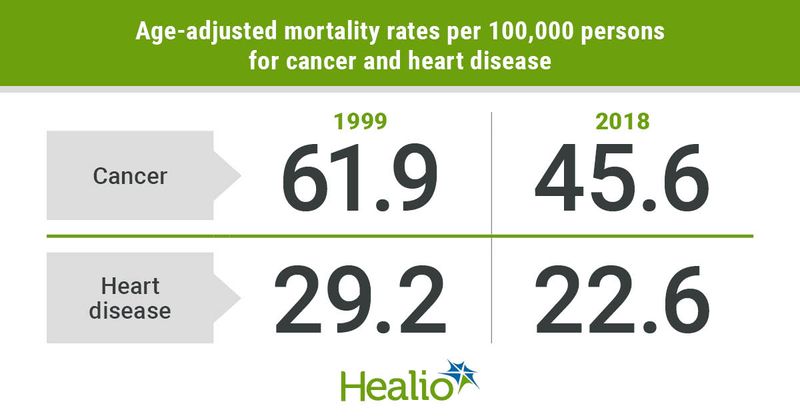Cancer, heart disease mortality gap decreasing in women younger than 65 years
The mortality gap between cancer and heart disease among women younger than 65 years has narrowed, researchers reported.
If the trends continue, heart disease could replace cancer as the leading cause of death in younger women, according to the researchers.


“Although CVD remains the leading cause of death for women overall, historically cancer had been the leading cause of death among young women less than 65 years of age,” Cardiology Today Editorial Board Member Erin D. Michos, MD, MHS, FACC, FAHA, FASE, director of Women’s Cardiovascular Health and associate director of preventive cardiology at the Ciccarone Center for the Prevention of Cardiovascular Disease at Johns Hopkins School of Medicine, told Healio. “There has been reversal of progress we have made in prior decades with heart disease deaths now on the rise for younger women. This is now a narrowing of the mortality gap between cancer and heart disease deaths in young women.”
Researchers analyzed the U.S. national database of death certificates of women younger than 65 years from the CDC Wide-ranging Online Data for Epidemiologic Research (WONDER) database from 1999 to 2018. Using these data, researchers measured annual percentage changes in age-adjusted mortality rates and years of potential life lost per 100,000 persons due to heart disease or cancer.
Compared with heart disease, cancer was the most prevalent cause of premature death among young women. There was a decrease in age-adjusted mortality rates per 100,000 persons for both cancer (61.9 vs. 45.6) and heart disease (29.2 vs. 22.6) from 1999 to 2018.
Annual percentage changes in age-adjusted mortality rates for heart disease rose from 2010 to 2018 (0.53; 95% CI, 0.18-0.89), whereas they both declined consistently over time for cancer. After 2008, these increases for heart disease were significant in the Midwest, medium/small metropolitan cities and rural areas.
There was an increase in annual percentage changes in age-adjusted mortality rates for heart disease among women aged 25 to 34 years (2.24; 95% CI, 0.3-4.22) from 2013 to 2018 and among women aged 55 to 64 years (0.46; 95% CI, 0.13-0.8) from 2009 to 2013. Annual percentage changes in age-adjusted mortality rates for heart disease also rose in non-Hispanic white younger women (0.79; 95% CI, 0.46-1.13) from 2009 to 2018 and in non-Hispanic American Indian/Alaskan Native younger women (2.71; 95% CI, 0.59-4.87) from 2011 to 2018.
Due to these increases in annual percentage changes in age-adjusted mortality rates for heart disease, the mortality gap between cancer and heart disease for women younger than 65 years has narrowed from 32.7 per 100,000 persons in 1999 to 23 per 100,000 persons in 2018.
Michos said in an interview that the American Heart Association published its 2030 Impact Goals in early 2020, which were to increase healthy life expectancy from age 66 years to at least 68 years across the U.S. and from age 64 years to at least 67 years worldwide, and to set additional targets for health equity and well-being.
“Unfortunately, our recent study has shown that we still have a lot of work cut out for us in the preventive/public health field to turn around these adverse trends for premature CVD in women or we are not going to meet the AHA’s 2030 Impact Goals,” Michos said.
To try and reverse these trends, Michos recommended partnering with community groups, faith-based organizations and patient advocacy groups along with diversifying the obstetric, primary care and cardiology workforce to include more clinicians from marginalized groups to better represent the patients served.
“There really is a need for more intensive efforts to address societal and medical inequalities may mitigate risk about Black women and should be undertaken to improve maternal health equity,” Michos said. “It is important to recognize unique risk factors that women experience across their lifespan that men do not, such as adverse pregnancy outcomes and early menopause, which are enhancing factors of CVD risk. We need to make sure that women get the appropriate preventative attention.”
For more information:
Erin D. Michos, MD, MHS, FACC, FAHA, FASE, can be reached at edonnell@jhmi.edu.
